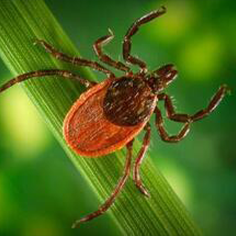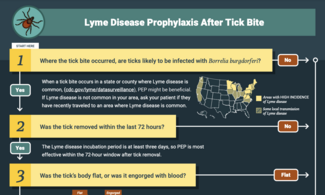Reports of tickborne diseases are on the rise in the U.S. and Vermont. States in the Northeast, Mid-Atlantic and Upper Midwest have the highest incidence of Lyme disease in the country. While Lyme disease is the most common tickborne disease in Vermont, other diseases like anaplasmosis and babesiosis are becoming more common.
Diagnosis and Treatment Best Practices for Tickborne Diseases
The blacklegged tick is responsible for spreading all five tickborne diseases in Vermont (in order of prevalence): Lyme disease, anaplasmosis, babesiosis, hard tick relapsing fever, and Powassan virus.

- People are most likely to be infected April through August when the abundance of host-seeking tick nymphs is highest.
- Nymphs are very small (< 2mm) and difficult to see unless they become engorged with blood. Even when engorged, nymphs may evade timely detection and removal.
- Up to half of people diagnosed with Lyme disease don’t recall being bitten by a tick.
Testing Considerations
Consider testing symptomatic patients.
Laboratory testing for tickborne diseases should be considered for patients presenting with non-specific influenza-like illness in the summer or fall, especially if there is a history of a tick bite or exposure to tick habitat. However, up to half of people diagnosed with Lyme disease don’t recall being bitten by a tick—likely due in part to tick nymphs very small size (<2mm) that makes detection and timely removal more difficult.
Signs and symptoms of tickborne disease may include:
- Fever
- Chills
- Malaise
- Headache
- Muscle and joint pains
- Lymphadenopathy
- Circular expanding rash (erythema migrans) found in 70% of Lyme disease cases.
Some patients with tickborne disease may also present with neurological, cardiovascular, hematologic or gastrointestinal symptoms.

